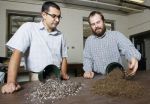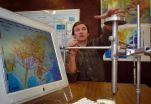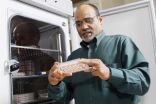(Press-News.org) HOUSTON, Oct. 25, 2010 – Some unexpected effects of lead exposure that may one day help prevent and reverse blindness have been uncovered by a University of Houston (UH) professor and his team.
Donald A. Fox, a professor of vision sciences in UH's College of Optometry (UHCO), described his team's findings in a paper titled "Low-Level Gestational Lead Exposure Increases Retinal Progenitor Cell Proliferation and Rod Photoreceptor and Bipolar Cell Neurogenesis in Mice," published recently online in Environmental Health Perspectives and soon to be published in the print edition of the prestigious peer-reviewed journal.
The study suggests that lead, or a new drug that acts like lead, could transform human embryonic retinal stem cells into neurons that would be transplanted into patients to treat retinal degenerations.
"We saw a novel change in the cellular composition of the retina in mice exposed to low levels of lead during gestation. The retina contained more cells in the rod vision pathway than normal or than we expected," said Fox, who also is a professor of biology and biochemistry, pharmacology and health and human performance. "The rod photoreceptors and bipolar cells in this pathway are responsible for contrast and light/dark detection. These new findings directly relate to the supernormal retinal electrophysiological changes seen in children, monkeys and rats with low-level gestational lead exposure."
Fox said these effects occur at blood lead levels at or below 10 micrograms per deciliter, the current low-level of concern by the Centers for Disease Control and Prevention. Because the effects occur below the "safe level," Fox says it raises more questions about what should be considered the threshold level for an adverse effect of lead on the brain and retina.
Fox has studied lead toxicity for 35 years, specifically as it relates to its effects on the brain and retina of children. His interest in gestational lead exposure started in 1999, when he and colleague Stephen Rothenberg studied a group of children in Mexico City whose mothers had lead exposure throughout their pregnancies. The study was funded to measure the adverse effects of lead poisoning on the nervous system of children born in Mexico City – a city that has elevated levels of lead in the air due to the use of leaded gasoline, as well as continued use of lead-containing pottery and glassware for food preparation. The study was funded by the U.S. Environmental Protection Agency and the Mexican government and was published in 2002 in the journal Investigative Ophthalmology and Visual Sciences.
Supported by a $1.7 million National Institutes of Health (NIH) grant, Fox and his group set out to find possible reasons for this supernormal retinal response in children. The researchers employed rat and mice models that covered the three levels of lead found in the blood of the Mexico City mothers – some below, some right at and some higher than the CDC "safe level." The researchers exposed rodents to lead throughout pregnancy and the first 10 days of life, which is a time period equivalent to human gestation.
Fox said that the early-born retinal progenitor cells give rise to four neuron types, which were not affected by lead exposure. The later-born retinal progenitor cells, he said, give rise to two types of neurons and a glial cell. Surprisingly, only the late-born neurons increased in number. The glial cells, which nurture neurons and sometimes protect them from disease, were not changed at all. The rats and mice both had "bigger, fatter retinas," according to Fox. Interestingly, the lower and moderate doses of lead produced a larger increase in cell number than the high lead dose.
"This is really a novel and highly unexpected result, because lead exposure after birth or during adulthood kills retinal and brain cells, but our study showed that low-level lead exposure during gestation caused cells to proliferate, increased neurons and did not affect glia," Fox said. "So, gestational exposure produces an exact opposite to what was previously shown by our lab and others. It also shows that the timing of chemical exposure during development is just as important as the amount of exposure."
This brought the researchers to a crossroads. On the one hand, the retina is not built to have all these extra cells and, according to unpublished data from Fox's mouse studies, the retinas will start to degenerate as the mice age. This suggests that the retinas of the children from the original Mexico City study should be examined as they might start to degenerate when they are 40 years of age.
"This work has long-term implications in retinal degeneration and diseases where photoreceptors die. If we can figure out how low-level lead increases the number of retinal progenitor cells and selectively produces photoreceptors and bipolar cells, then perhaps a drug can be created to help those with degenerative retinal diseases that eventually cause blindness," Fox said. "Researchers may be able to use lead as tool in transforming embryonic retinal stem cells into rods and bipolar cells that could be transplanted into diseased retinas, ultimately saving sight and reversing blindness."
Fox said that more research is needed before such a potential drug could be developed to mimic the effects of lead. Ideally, this drug would induce human embryonic retinal stem cells to form rods and bipolars that could be transplanted into patients to treat early stages of retinal degeneration.
INFORMATION:
In addition to Fox and research assistant professor Dr. Weimin Xiao in the UHCO, the research team consisted of a number of Fox's current and former students, including Anand Giddabasappa, a former Ph.D. student and now UHCO alumnus; Jerry E. Johnson, a UH alumnus from the department of biology and biochemistry, former post-doctoral fellow in Fox's lab and now an assistant professor at UH-Downtown; and current Ph.D. students W. Ryan Hamilton, Shawntay Chaney and Shradha Mukherjee.
Supplementing the NIH research project grant, this study also was funded by National Eye Institute training and core grants and a National Institute for Occupational Safety and Health educational resource grant.
A copy of the article can be found at http://ehp03.niehs.nih.gov/article/info:doi/10.1289/ehp.1002524.
NOTE TO JOURNALISTS: High-resolution photos of Donald Fox and his research team are available to media by contacting Lisa Merkl.
About the University of Houston
The University of Houston is a comprehensive national research institution serving the globally competitive Houston and Gulf Coast Region by providing world-class faculty, experiential learning and strategic industry partnerships. UH serves more than 38,500 students in the nation's fourth-largest city, located in the most ethnically and culturally diverse region of the country.
About the UH College of Optometry
Since 1952, the University of Houston College of Optometry (UHCO) has educated and trained optometrists to provide the highest quality vision care. One of only 20 optometry schools in the country, UHCO offers a variety of degree programs, including Doctor of Optometry (O.D.), a combined Doctor of Optometry/Doctor of Philosophy (O.D./Ph.D.), Master of Science (M.S.) and Doctor of Philosophy (Ph.D.). UHCO serves an average of 36,000 patients a year through The University Eye Institute and its satellite clinics.
For more information about UH, visit the university's Newsroom at http://www.uh.edu/news-events/.
To receive UH science news via e-mail, visit http://www.uh.edu/news-events/mailing-lists/sciencelistserv/index.php.
For additional news alerts about UH, follow us on Facebook at http://www.facebook.com/UHNewsEvents and Twitter at http://twitter.com/UH_News.
Unexpected findings of lead exposure may lead to treating blindness
Research team at UH sees novel changes in retinal anatomy, results published in high-impact journal
2010-10-26
ELSE PRESS RELEASES FROM THIS DATE:
Rice hulls a sustainable drainage option for greenhouse growers
2010-10-26
WEST LAFAYETTE, Ind. - Greenhouse plant growers can substitute rice hulls for perlite in their media without the need for an increase in growth regulators, according to a Purdue University study.
Growing media for ornamental plants often consists of a soilless mix of peat and perlite, a processed mineral used to increase drainage. Growers also regularly use plant-growth regulators to ensure consistent and desired plant characteristics such as height to meet market demands. Organic substitutes for perlite like tree bark have proven difficult because they absorb the plant-growth ...
As Arctic warms, increased shipping likely to accelerate climate change
2010-10-26
As the ice-capped Arctic Ocean warms, ship traffic will increase at the top of the world. And if the sea ice continues to decline, a new route connecting international trading partners may emerge -- but not without significant repercussions to climate, according to a U.S. and Canadian research team that includes a University of Delaware scientist.
Growing Arctic ship traffic will bring with it air pollution that has the potential to accelerate climate change in the world's northern reaches. And it's more than a greenhouse gas problem -- engine exhaust particles could ...
UF research gives clues about carbon dioxide patterns at end of Ice Age
2010-10-26
GAINESVILLE, Fla. — New University of Florida research puts to rest the mystery of where old carbon was stored during the last glacial period. It turns out it ended up in the icy waters of the Southern Ocean near Antarctica.
The findings have implications for modern-day global warming, said Ellen Martin, a UF geological sciences professor and an author of the paper, which is published in this week's journal Nature Geoscience.
"It helps us understand how the carbon cycle works, which is important for understanding future global warming scenarios," she said. "Ultimately, ...
Purdue-led research team finds Haiti quake caused by unknown fault
2010-10-26
WEST LAFAYETTE, Ind. - Researchers found a previously unmapped fault was responsible for the devastating Jan. 12 earthquake in Haiti and that the originally blamed fault remains ready to produce a large earthquake.
Eric Calais, a Purdue University professor of earth and atmospheric sciences, led the team that was the first on the ground in Haiti after the magnitude 7.0 earthquake, which killed more than 200,000 people and left 1.5 million homeless.
The team determined the earthquake's origin is a previously unmapped fault, which they named the LÄogëne fault. The newly ...
Substantial consumption of fluoride increases chance of mild fluorosis
2010-10-26
CHICAGO, Oct. 25, 2010 – Young children who consume substantial amounts of fluoride through infant formula and other beverages mixed with fluoridated water or by swallowing fluoride toothpaste have an increased chance of developing mild enamel fluorosis, according to research published in the October issue of The Journal of the American Dental Association and supported by the National Institute of Dental and Craniofacial Research. Children can continue using fluoridated water and fluoride toothpaste because fluoride has been proven to prevent tooth decay, and mild fluorosis ...
MicroRNAs dictate the Epstein-Barr virus' elaborate waiting game, cancer formation
2010-10-26
While most commonly associated with mononucleosis, Epstein-Barr virus (EBV) has been linked to many diseases that affect people long after the initial infection takes place, including some forms of cancer. In the current issue of the Journal of Biological Chemistry, scientists at The Wistar Institute describe how viral microRNA – small segments of RNA that suppress the effects of gene activity – allows EBV to hide within cells and evade the immune system. The scientists believe their findings may one day enable physicians to flush EBV out of hiding, allowing a healthy immune ...
Researchers find a stable way to store the sun's heat
2010-10-26
CAMBRIDGE, Mass. -- Researchers at MIT have revealed exactly how a molecule called fulvalene diruthenium, which was discovered in 1996, works to store and release heat on demand. This understanding, reported in a paper published on Oct. 20 in the journal Angewandte Chemie, should make it possible to find similar chemicals based on more abundant, less expensive materials than ruthenium, and this could form the basis of a rechargeable battery to store heat rather than electricity.
The molecule undergoes a structural transformation when it absorbs sunlight, putting it into ...
Listeria clever at finding its way into bloodstream, causing sickness
2010-10-26
WEST LAFAYETTE, Ind. - Pathogenic listeria tricks intestinal cells into helping it pass through those cells to make people ill, and, if that doesn't work, the bacteria simply goes around the cells, according to a Purdue University study.
Arun Bhunia, a professor of food science, and Kristin Burkholder, a former Purdue graduate student who is now a postdoctoral researcher in microbiology and immunology at the University of Michigan Medical School, found that listeria, even in low doses, somehow triggers intestinal cells to express a new protein, heat shock protein 60, ...
Modern humans emerged far earlier than previously thought
2010-10-26
An international team of researchers based at the Institute of Vertebrate Paleontology and Paleoanthropology in Beijing, including a physical anthropology professor at Washington University in St. Louis, has discovered well-dated human fossils in southern China that markedly change anthropologists perceptions of the emergence of modern humans in the eastern Old World.
The research was published Oct. 25 in the online early edition of the Proceedings of the National Academy of Sciences.
The discovery of early modern human fossil remains in the Zhirendong (Zhiren Cave) ...
'Fracking' mobilizes uranium in marcellus shale
2010-10-26
BUFFALO, N.Y. -- Scientific and political disputes over drilling Marcellus shale for natural gas have focused primarily on the environmental effects of pumping millions of gallons of water and chemicals deep underground to blast through rocks to release the natural gas.
But University at Buffalo researchers have now found that that process -- called hydraulic fracturing or "fracking"-- also causes uranium that is naturally trapped inside Marcellus shale to be released, raising additional environmental concerns.
The research will be presented at the annual meeting of ...
LAST 30 PRESS RELEASES:
Tracing the quick synthesis of an industrially important catalyst
New software sheds light on cancer’s hidden genetic networks
UT Health San Antonio awarded $3 million in CPRIT grants to bolster cancer research and prevention efforts in South Texas
Third symposium spotlights global challenge of new contaminants in China’s fight against pollution
From straw to soil harmony: International team reveals how biochar supercharges carbon-smart farming
Myeloma: How AI is redrawing the map of cancer care
Manhattan E. Charurat, Ph.D., MHS invested as the Homer and Martha Gudelsky Distinguished Professor in Medicine at the University of Maryland School of Medicine
Insilico Medicine’s Pharma.AI Q4 Winter Launch Recap: Revolutionizing drug discovery with cutting-edge AI innovations, accelerating the path to pharmaceutical superintelligence
Nanoplastics have diet-dependent impacts on digestive system health
Brain neuron death occurs throughout life and increases with age, a natural human protein drug may halt neuron death in Alzheimer’s disease
SPIE and CLP announce the recipients of the 2025 Advanced Photonics Young Innovator Award
Lessons from the Caldor Fire’s Christmas Valley ‘Miracle’
Ant societies rose by trading individual protection for collective power
Research reveals how ancient viral DNA shapes early embryonic development
A molecular gatekeeper that controls protein synthesis
New ‘cloaking device’ concept to shield sensitive tech from magnetic fields
Researchers show impact of mountain building and climate change on alpine biodiversity
Study models the transition from Neanderthals to modern humans in Europe
University of Phoenix College of Doctoral Studies releases white paper on AI-driven skilling to reduce burnout and restore worker autonomy
AIs fail at the game of visual “telephone”
The levers for a sustainable food system
Potential changes in US homelessness by ending federal support for housing first programs
Vulnerability of large language models to prompt injection when providing medical advice
Researchers develop new system for high-energy-density, long-life, multi-electron transfer bromine-based flow batteries
Ending federal support for housing first programs could increase U.S. homelessness by 5% in one year, new JAMA study finds
New research uncovers molecular ‘safety switch’ shielding cancers from immune attack
Bacteria resisting viral infection can still sink carbon to ocean floor
Younger biological age may increase depression risk in older women during COVID-19
Bharat Innovates 2026 National Basecamp Showcases India’s Most Promising Deep-Tech Ventures
Here’s what determines whether your income level rises or falls
[Press-News.org] Unexpected findings of lead exposure may lead to treating blindnessResearch team at UH sees novel changes in retinal anatomy, results published in high-impact journal





